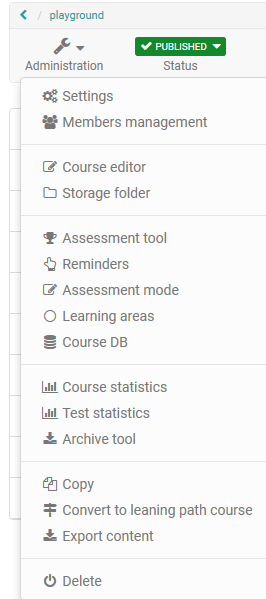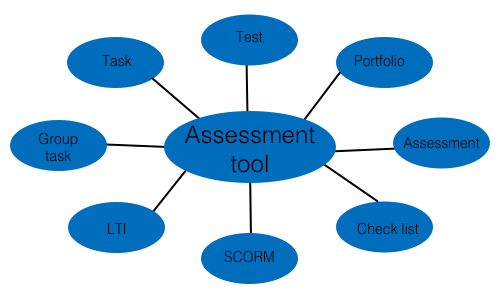On this page you get an overview of the course tools of the "Administration". Not only courses, but all learning resources have the area "Administration" with further submenus.
Some course administration tools are presented on separate pages.
A number of tools are available in the "Administration" area of your course. You can organize course participants and course-related groups in the members management. Groups can also be bundled in learning areas. The course structure and the course tools are set up in the course editor. Furthermore, you have access to the storage folder of a course.
During the course itself the assessment tool is relevant. Course-related reminders and lectures can also be organized. The assessment mode is suitable for online exams. Certain statistical data can also be retrieved and data archived. And of course courses and learning resources can be copied, exported or deleted.
Here is an overview of the individual menus:
Assessment Tool
In the menu "Assessment tool," not to be confused with the course element "Assessment," the entire assessment of a course is carried out. Here you have access to all course elements that can be assessed and you can make assessments with points awarded, passed/failed and give individual feedback.
The menu Assessment Tool is therefore relevant during the course or at the end.
All owners of courses have access to the assessment tool as well as members of a corresponding right group and, last but not least, all coaches. Owners may assess all course participants, tutors only those they have been assigned to. The course elements which should be assessed, first need to configured either in the tab "Assessment" or "Test configuration". Only if the assessment is turned on an assessment in the assessment tool becomes possible. To pass a course, the tab "Score" in the course element needs to be filled in.
Further information about the assessment tool you can found here.
Course Statistics
This course function provides you with statistics regarding access to your OpenOlat course. All course owners have access to those statistics. You will receive data in the form of tables as well as in the form of charts. Table data can be downloaded as Excel files (e.g. for further processing) to your computer.
Relevant for your total of course accesses are user clicks on a single course element; however, clicks on this element's content will not be counted. If a user selects the Wiki from course navigation and clicks it three times, three clicks will be counted; no click will be counted though when clicking on a link within that Wiki.
Statistics can be created per hour, per day, per weekday or per week. Furthermore you can choose a certain period of time per day and per week during which any course access should be displayed in your statistics.
When selecting a course element in your table its corresponding chart will be displayed. If you select the number of clicks in the row "Total" your chart will show all accesses sorted by course element.
Test Statistics
The test statistics allow you to perform general course-related, anonymous statistical evaluations of your tests. All tests included in the course are displayed. The key figures for a test as well as further analyses of the time taken to complete a test, average points per question and the percentage of correct answers per question are displayed. In addition, key figures such as the number of participants who completed the question, average score, time taken to complete the question, etc. are displayed and visualized for each question.
You can evaluate a test with regard to e.g. difficulty and suitability by means of characteristic values for test evaluation and item analysis.
Access to the test statistics is not only available to the course owners but also to all coaches of the course.
Questionnaire statistics
The questionnaire statistics allow you to make a general course-related, anonymous statistical evaluation of your questionnaires/surveys. For each survey there is an overview, tables, diagrams and access to the individual questionnaires.
The overview includes key figures such as the number of completed questionnaires, submission period and processing time. The tab "Tables" contains evaluations for individual questions. In the tab "Diagrams" the results are visualised in the form of bar charts and the corresponding statistical data such as median, variance and standard deviation are displayed. In the tab "Individual questionnaires" you have access to each individual questionnaire. All accesses are anonymous.
Besides course owners all coaches have access to questionnaire statistics.
Learning Areas
Learning areas are used to easily assign groups to different elements within a course.
By using the button "Create learning area" you can create a new learning area before allocating single groups to this learning area. If a learning area already exists you can use this one to allocate linked groups. All you have to do is editing the learning area, and then selecting the designated groups in the tab "Group assignment". If no groups have been created yet, the text appears: No learning group was found. Please create a learning group in the members management first.
Learning areas can be selected in the course editor, for example in the course element "Enrolment." This way all groups of a learning area will be offered for enrolment. Furthermore learning areas are available in the tabs "Visibility" or "Access" in conventional courses if the option "group-dependent" has been activated.
The advantage over explicitly listing all relevant groups in the tabs "Access" and "Visibility" is a greater flexibility and easier handling in the course editor. If new group rules are defined in a course it has to be republished. If instead a learning area rule has been defined, the participation of a group can be defined in the learning area administration. In that case you do not have to republish your course.
Course DB
Here you can create a new course-specific database that can store certain course-specific information.
Booking methods
Here you will find an overview of all the people who have booked your course.
Copy learning resource
Learning resources are copied in order to be able to reuse an old course structure for a new semester, for example. When copying a course, the structure, folder contents, HTML pages and group names (without group members) are copied. User data such as forum entries, group members, etc. are not copied. As the owner of a learning resource, you can determine (under "Access configuration") whether your learning resource can also be copied by other OpenOlat authors.
This way you get a completely reset course without user-specific data remains.
As owner of a learning resource you can also determine in the administration menu under "Settings" → "Share" whether your learning resource may be copied by all other OpenOlat authors of the system.
A course copy can also usefully be created as a backup after the course has been completed and before the course begins.
Convert to Learning Path Course
Traditional courses and courses created before OpenOlat version 15 can be converted into a learning path course via this link.
Export content
Export your learning resources as a ZIP file. You can import tests, questionnaires, CP and SCORM learning content into other LMSs that support the same standard. Courses, wikis and glossaries can be imported into other OpenOlat installations.
As the owner of a learning resource, you can also determine in the administration menu under "Settings" → "Shared to other authors" whether your learning resource may be exported, copied or referenced by all other OpenOlat authors in the system.
Allowing a course copy for other authors is useful for course templates, for example.
Delete learning resources
You can delete them using the menu item in the "Administration" area. When deleting integrated learning resources (e.g. a test) you will receive a message with the display of the corresponding course. You must therefore first delete the course element "Test" in the course so that you can delete the test in the authoring area. The data is definitely deleted and cannot be restored. Therefore a confirmation is necessary before deleting.
However, if the course is deleted, all user data will be removed. Course participants and authors no longer have access. Only the course owner has access and finds the course in the authoring area under the tab "Deleted". There the course can be restored, but without user data, these are permanently deleted.
When you delete a course, user data (e.g. test results) is first archived as an Excel file in your personal folder and then deleted.
It is possible to inform other course owners via e-mail about the completion or deletion of a course. This can either be optionally selected in the Finish/Delete dialog or set in the administration system-wide.
A course can also be closed or deleted automatically. The administrator makes the appropriate settings under Administration.




